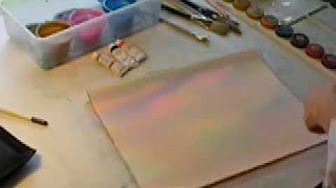Lesson 23
by Mary Ann Boysen
PAINTING with COLOR…using the Complements

This image is from one of my videos on Youtube.
It shows how I begin each painting with three washes. This is just a little strong so that you can see the colors, but when you start adding your details in a floral, landscape, portrait, etc. you will notice that these initial colors appear to be white! These washes give life to the painting rather than just a white surface.
I begin with a wash of Quinacridone Gold, followed by a wash of Opera, and when those two are dry, I add Cobalt Blue Hue. If you add the blue when the others are wet, you will get a gray. Otherwise, all the colors glow.
When I began to learn to paint, my landscapes were dull and lifeless and without much color. Cold winter scenes, blah landscapes and muddy greens. After much reading, practicing and watching what the decorators were bringing into my art gallery and framing business, I realized that strong color was more and more important in the home. It was what most people wanted when they decided to redecorate their homes.
There are times that softer colors are needed and welcomed as a contrast to bold areas of a painting. Variation on a theme is as important in painting as it is in music. Let those colors, whether soft or bold, sing! Let them carry the viewer through the painting and create excitement for what might be around the corner.
Let techniques be soft, busy, determined or whimsical. Entertain the viewer.
The use of complementary colors is a powerful tool and applying them can make the difference in the success of a painting. Mixing them together, however, can be the destruction of a painting. They turn grey, or brown, or black depending on the amounts of each color in the mixture. A successful way to use complementary colors is to lay a bit of each color side by side on the mixing palette or even in different mixing wells. Then take a clean, damp brush and pick up a bit of each color and apply it to the paper. Allow the colors to mix on the page rather than on the palette. This allows the marriage of the colors which keeps the complementary nature of the pigments fresh and exciting.
The one frustration for beginning painters is mixing the color green. Green from the tube can be raw and bitter. Adding cool colors to it changes its temperature. Adding warm colors can make it muddy if you add the wrong warm color! After all, green is a mixture of blue and yellow, so when you add a warm red shade, which is the third primary, therein lies the problem! The safest way to change the shades of green in your landscape is to keep the paper very wet, and allow colors to mix on the paper as stated above. They will create a glow rather than a dull color.
The Impressionists laid strokes of blue and yellow side by side to create a green glow in their paintings. The shades of blue and yellow could change throughout the painting to carry the eye and delight the viewer. Their paintings were never muddy because they didn’t mix colors but laid them side-by-side. Their strokes were vibrant, and though they are not photo-realists, people from all over the world travel all over the world to see the exhibits that feature their paintings.
There are many styles of painting in this world, and a market for each and every one of them. Viva la difference! This makes each art show and gallery exhibition exciting. If the paintings were all alike and the styles all the same, we would never return after the first viewing! |

